Assembly Plant of the Year: When the Hauling Gets Rough, the Tough Turn to Kenworth
For more than 80 years, Kenworth Truck Co. (Kirkland, WA) has enjoyed a reputation for building vehicles known for their durability, reliability and dependability. The company's trucks are a common sight on the highways and roads of America. But, the custom-built vehicles are also hard at work every day pulling extreme loads in remote locations never seen by the public.
For example, Robinson Transport Inc. (Salina, UT) has been hauling coal out of mines near Salina, UT, for almost 60 years. It relies on trucks built at Kenworth's 270,000-square-foot assembly plant in Renton, WA. The facility recently received ASSEMBLY magazine's inaugural Assembly Plant of the Year award.
Robinson's fleet is all Kenworth, with 60 W900 models. Its trucks are equipped with 475-hp Caterpillar diesel engines driven through 10-speed Eaton transmissions and equipped with 46,000-pound rear axles. The trucks have a 200-inch wheelbase. They pull 32- and 36-cubic-yard double hopper-bottom aluminum trailers.
"We need a powerful truck to carry 129,000-pound gross weight up and down grades of up to 9 percent 6 times per day per truck," says Kim Robinson, president of Robinson Transport. "Our Kenworths are tough, well-built and able to stand up to the up-shifting and down-shifting and tight turns. It is critical that we keep running and stay on schedule. And our drivers appreciate the reliability because they are paid by the load, plus they like to get home each night."
Drivers follow a predictable, though very demanding route. They drive 30 miles from Salina to a coal mine in the Coal Cliffs range, going from 5,000 feet elevation to 9,000 feet then down to 7,000 feet and back to 9,000 feet again on their way to their destination. Drivers also must navigate sharp turns while on the mine road. The trucks transport coal to a dump yard for loading into rail cars, to electric power plants or to the Kennecott Copper mine near Salt Lake City.
Robinson hauls 3.5 million tons of coal a year under a long-term contract. At the coal mine, an overhead hopper loads 43 tons of coal into each truck in 45 seconds. Every 24 hours, Monday through Friday, 900 truckloads are loaded at the mine in a continuous process that could last another 30 years.
The trucks are working 22 hours a day, 5 or 6 days a week. Robinson Transport's maintenance shop takes care of all repairs and servicing, ranging from tire changing to washing, during a 2-hour daily window to keep the trucks on the road. Each truck in the fleet logs approximately 250,000 miles a year.
When the University of Arizona needed to move a huge mirror to a 10,480-foot mountain top to begin building the world's largest, most powerful telescope, it chose Precision Heavy Haul Inc. (Tolleson, AZ). The company used a Renton-built Kenworth T800 to pull the delicate mirror up the mountain.
The recent project involved transporting a 27.5-foot diameter parabolic mirror and the mirror cell which supports the mirror once installed on a large binocular telescope at the 16-story Mount Graham International Observatory at Safford, AZ. When completed, the telescope will be 10 times as powerful as the Hubble Space Telescope.
"This was the most complex move with the most challenges that we've ever had to overcome, but everything went exactly as planned," says Michael Poppe, president of Precision Heavy Haul. "This was an extraordinary achievement between our team and our equipment.
"This job shows why we have an all-Kenworth fleet of trucks," adds Poppe. "Kenworth builds the best custom-engineered heavy-duty trucks on the market. The combination of the biggest engine we could get plus the 195-inch wheelbase delivered the traction and the tight turning radius we needed. This gave us great maneuverability for making those close to 180-degree turns climbing the mountain trail. Also, we needed a unit with a gear ratio low enough to go less than 1 mph without stalling."
The $10 million mirror was hauled in a specially designed steel box outfitted with 280 pneumatic actuators that restrained and cushioned it. The mirror and box were 30 feet square and 9 feet thick, and weighed a combined 55 tons. The 29-foot diameter cell weighed 50 tons and was moved separately.
Cranes hoisted the mirror and casing onto a special trailer with 12 axles. Steel plates weighing 70,000 pounds were loaded onto the trailer's front deck to lower the overall center of gravity. Over several days, the Kenworth T800, powered by a 565-hp Cummins engine and driven through an 18-speed Eaton transmission, pulled the extreme load. In addition, a Caterpillar 980 wheel loader was used to push the massive, but fragile, cargo at speeds ranging up to 4 mph.
The route covered 122 miles of interstate and state highway roads from the University of Arizona lab to a mountain base camp, in addition to the final 29 miles to the mountain top, up rough road with numerous hairpin turns. A team of Precision Heavy Haul employees, accompanied by scientists and state patrol officers, negotiated 523 curves at grades up to 12 percent with lateral slopes of 22 percent over the road.
Looking for a reprint of this article?
From high-res PDFs to custom plaques, order your copy today!







